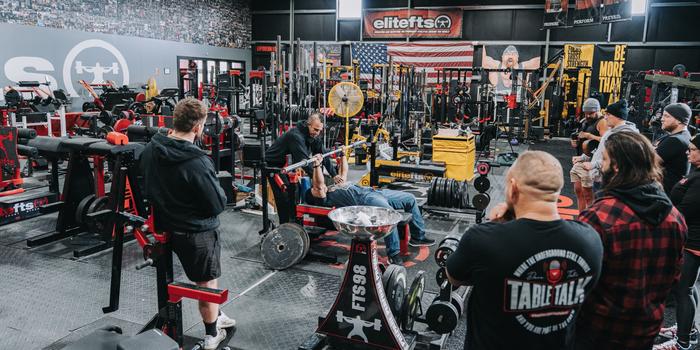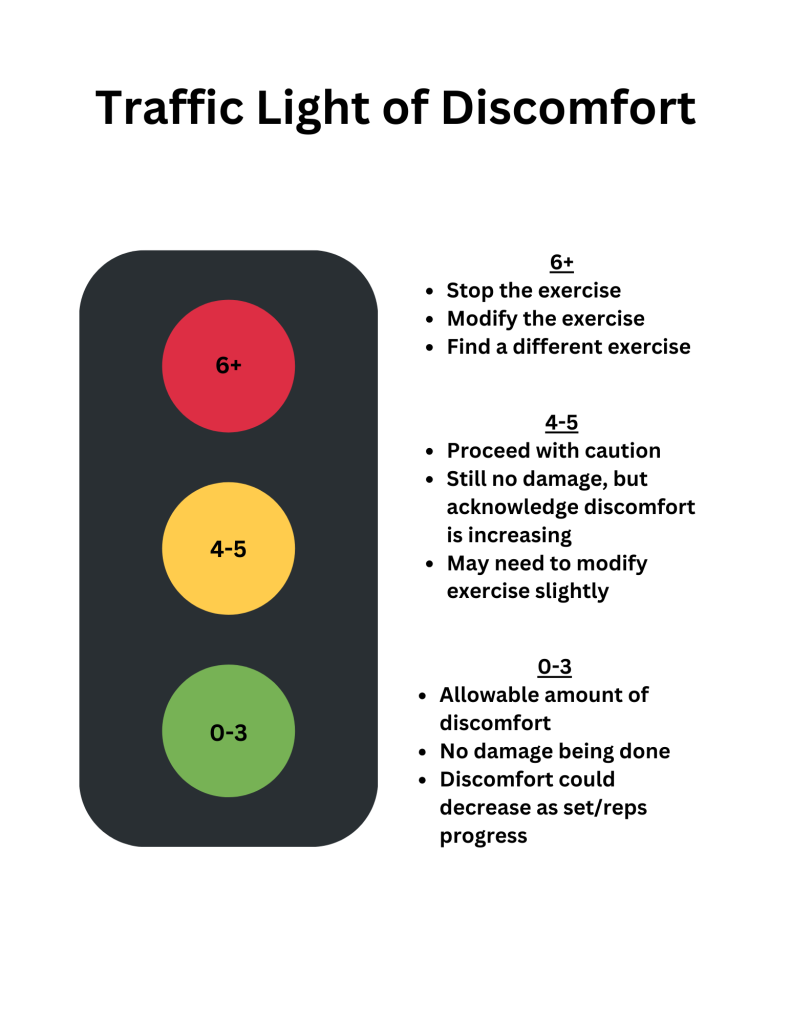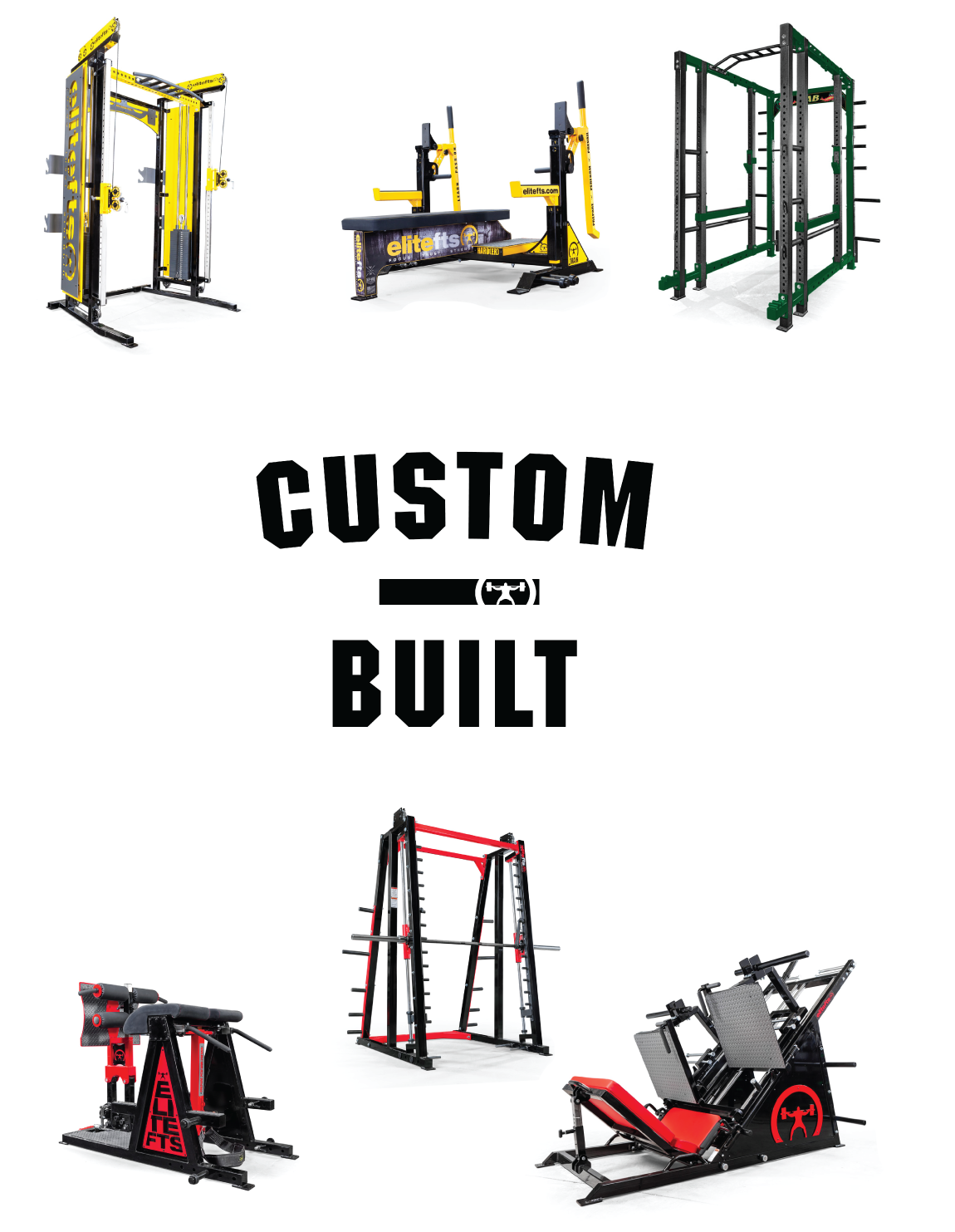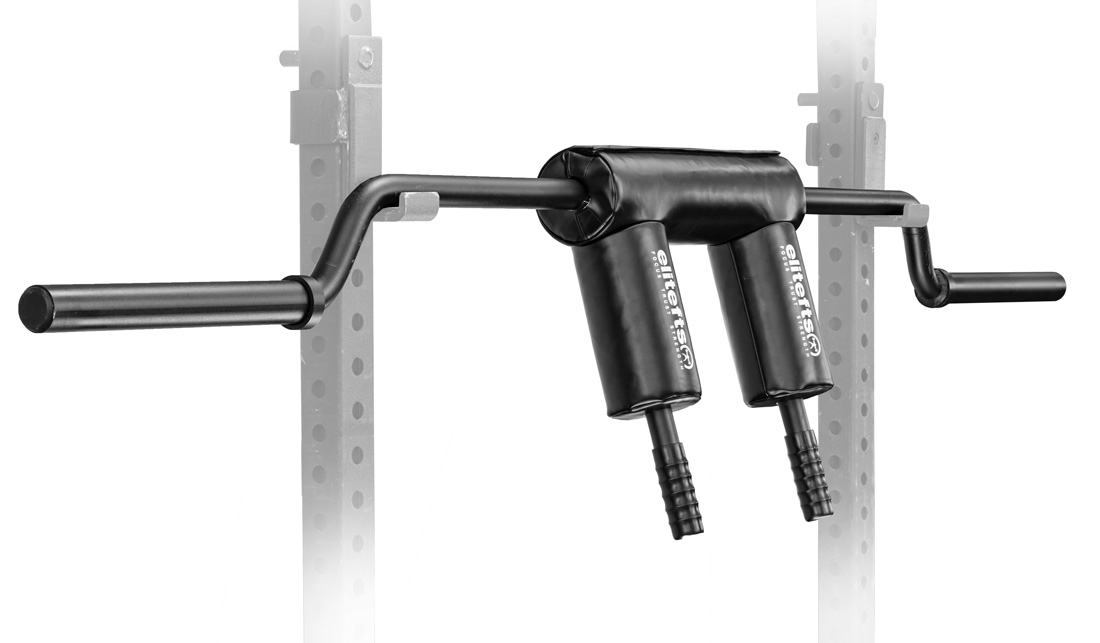
Nobody wants to be sidelined from training longer than necessary. When
you're recovering from an injury, it's crucial not to do anything that could
slow down your progress. In my experience working with barbell athletes,
I've observed that they often struggle to make informed decisions about
their training when they're not under direct supervision. This is where the
concept of the "traffic light of discomfort" becomes valuable.
I didn't originate this idea. As a clinician, I've found it tremendously
beneficial for my athletes when they're training independently. The traffic
light metaphor provides a clear framework for athletes to gauge their
discomfort levels during exercises, and make informed choices about how
to proceed.
The traffic light analogy divides discomfort into three zones: green, yellow,
and red. Each zone corresponds to a different level of discomfort, signaling
whether an athlete should continue with their current exercise, proceed
with caution, or stop altogether.

Green Light (0-3):
The green light zone represents a discomfort level
ranging from 0 to 3 out of 10. During rehabilitation, the primary goal is to
engage in exercises without experiencing pain. However, it's normal to feel
some discomfort as tissues heal and muscles strengthen. A discomfort
level of 0 to 3 is considered manageable and generally safe. It might not
feel pleasant, but it's unlikely to cause harm or exacerbate the injury.
As athletes progress through their exercises, they often find that
discomfort decreases over time. This phenomenon underscores the
therapeutic benefits of active rehabilitation. By gradually increasing
movement and activity levels, athletes regain confidence in their ability to
manage their recovery process.
Yellow Light (4-5):
The yellow light zone indicates a discomfort level ranging from 4 to 5 out of 10. At this level, discomfort is more noticeable and requires caution. While discomfort in the yellow zone isn't severe enough to stop the exercise immediately, athletes should pay close
attention to how their body responds. Modifications to the exercise may be
necessary to reduce discomfort and prevent potential injury.
Common adjustments in the yellow zone include reducing the weight lifted,
adjusting the range of motion, or using supportive equipment such as
sleeves or slingers. These modifications help athletes continue their
rehabilitation safely while allowing tissues to heal and strengthen without
undue stress or strain.
Red Light (6+):
The red light zone signifies a discomfort level of 6 or higher
out of 10. Just as a red traffic light signals "stop," experiencing discomfort
in this range during rehabilitation requires immediate cessation of the
exercise. Discomfort at this intensity indicates that the exercise is too
strenuous and may risk exacerbating the injury or hindering the recovery
process.
When an athlete encounters discomfort in the red zone, it's crucial to
switch to a different exercise or modify the current exercise significantly.
Choosing exercises that minimize discomfort while still targeting the same
muscle groups allow athletes to continue making progress in their
rehabilitation program without compromising their recovery.
Implementing the Traffic Light:
The traffic light of discomfort serves as a valuable tool for athletes and
therapists alike. It provides a systematic approach to monitoring
discomfort levels during exercises and empowers athletes to make
informed decisions about their training outside of clinic sessions.
Guidance from a skilled clinician is essential in implementing the traffic
light framework effectively. Clinicians work closely with athletes to
establish personalized rehabilitation plans that incorporate the principles of
the traffic light. By educating athletes on how to interpret and respond to
discomfort levels, therapists empower them to take an active role in their
recovery journey.
Athletes benefit from understanding the rationale behind the traffic light
system. It helps them develop a greater awareness of their body's signals
and responses during exercises. By learning to differentiate between
manageable discomfort and potentially harmful pain, athletes become
better equipped to modify their training accordingly and avoid setbacks in
their recovery.
The traffic light metaphor extends beyond its practical application during
exercises. It promotes a mindset of self-awareness and proactive decision-
making in athletes. By encouraging athletes to listen to their bodies and
adjust their training based on real-time feedback, the traffic light fosters a
sense of autonomy and confidence in managing their rehabilitation
independently.
Beyond the Clinic:
The utility of the traffic light of discomfort extends beyond the confines of
the clinic. Athletes often face challenges in maintaining their rehabilitation
regimen outside of scheduled clinic sessions. The traffic light framework
equips athletes with a practical tool to navigate these challenges and make
informed decisions about their training in real-time.
Outside of clinic sessions, athletes encounter varying environments and
circumstances that may impact their rehabilitation progress. The traffic
light system provides a consistent and reliable method for athletes to
assess discomfort levels and adjust their exercises accordingly. Whether
training at home, in a gym, or during competitive events, athletes can apply
the principles of the traffic light to ensure they continue making strides in
their recovery journey.
Empowering Athletes:
Empowering athletes through education and autonomy is a fundamental
aspect of effective rehabilitation. The traffic light of discomfort not only
guides athletes in managing their physical recovery but also instills a sense
of ownership and accountability in their rehabilitation process. By
understanding how to interpret discomfort levels and respond
appropriately, athletes develop resilience and confidence in overcoming
challenges on their path to recovery.
The role of the therapist extends beyond prescribing exercises and
monitoring progress. Therapists serve as educators and mentors,
equipping athletes with the knowledge and tools they need to navigate their
rehabilitation journey successfully. Through collaborative efforts and open
communication, therapists and athletes work together to achieve optimal
outcomes and promote long-term health and wellness.
Incorporating Feedback and Progress Monitoring:
Monitoring progress and adjusting rehabilitation plans based on feedback
are integral components of the traffic light framework. Athletes and
therapists regularly review discomfort levels and exercise outcomes to
assess progress and identify areas for improvement. By tracking changes
in discomfort levels over time, athletes gain insights into their rehabilitation
progress and can celebrate achievements while addressing challenges.
Clinicians play a pivotal role in facilitating ongoing feedback and progress
monitoring. Regular evaluations allow clinicians to fine-tune rehabilitation
plans and modify exercises as needed to optimize outcomes. By adapting
exercises to accommodate changes in discomfort levels and physical
capabilities, therapists ensure that athletes continue to make steady
progress toward their recovery goals.
Conclusion:
The traffic light of discomfort offers a structured approach to managing
rehabilitation exercises and empowering athletes to take charge of their
recovery journey. By categorizing discomfort into distinct zones and
providing guidelines for appropriate responses, the traffic light system
promotes safety, efficacy, and autonomy in rehabilitation practices.
Athletes who embrace the principles of the traffic light system gain
valuable skills in self-assessment and decision-making. They learn to
recognize their body's signals, differentiate between manageable
discomfort and potential injury, and adjust their training accordingly to
support optimal recovery and performance.
As clinicians, we play a vital role in educating and supporting athletes
through their rehabilitation process. By integrating the traffic light of
discomfort into our practice, we empower athletes to navigate challenges
confidently, make informed decisions about their training, and ultimately
achieve their goals of returning to training and reaching new personal bests.
The traffic light of discomfort represents more than a practical tool—it
embodies a philosophy of holistic care and empowerment in rehabilitation.
By fostering a collaborative partnership between clinicians and athletes, we
create a supportive environment where athletes can thrive, overcome
adversity, and emerge stronger on their journey to recovery and beyond.
Dr. Nick Calandra is a powerlifter with experience in raw and single ply. Dr. Nick has earned his bachelor's degree in Applied Exercise Science from Springfield College as well as a Doctorate in Chiropractic from Northeast College of Health Sciences. He is the owner and lead clinician of Beacon Chiropractic & Performance, a rehab chiropractic clinic based in Massachusetts specializing in the treatment of strength athletes.








